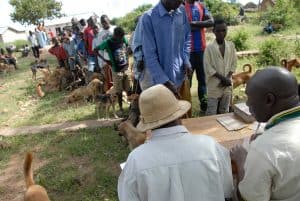Guy Palmer is working globally to help stop rabies
written by Sheila G. Miller
With an office in Nairobi, Kenya, a satellite office in Arusha, Tanzania, and a partnership with the Nelson Mandela African Institute of Science and Technology, Washington State University faculty members and staff are using animal science to make a difference in the lives of Africans.
The Paul G. Allen School of Animal Health is fifteen years into a massive project to vaccinate dogs against rabies, a disease that kills thousands in Africa and Asia every year. The school does more than just the rabies elimination program—it has been working to decrease childhood stunting (in which a child is physically and cognitively stunted as a result of malnutrition) through livestock vaccinations, and has also studied how to cut antibiotic resistance in urban slums in Nairobi.
Guy Palmer, who among other things is the founding director of the Allen School and leads the disease control programs in East Africa and Latin America, believes rabies deaths can be eliminated, and his team is out to make it a reality.
Interview with Guy Palmer
Why rabies?
Rabies is responsible for about 60,000 deaths worldwide, and almost all of them occur in Sub-Saharan Africa and South Asia. Even though here in the U.S. we have endemic wildlife rabies, in most years we have zero, maybe one death due to rabies. Once you develop symptoms of rabies you’re going to die—it’s a 100 percent deal, so you don’t want to have symptoms. Almost all rabies worldwide is due to dog bites. It is a global health problem.
What is WSU doing to eradicate rabies?
We want to reduce the need for treatment by reducing the number of rabid dogs. We have an effective vaccine—this is not like HIV where we don’t have an effective vaccine. We have one, it’s just a matter of getting it delivered consistently out to the right places to block transmission. If you vaccinate enough dogs, then you basically keep the virus from circulating among the dogs and then dogs don’t have rabies and can’t transmit to humans.
The number of those dogs that have to be vaccinated is on average about 70 percent of population. You don’t have to vaccinate every dog, but you have to get a good number. There are challenges to these resource-poor areas, places where people live on less than $1.50 a day. They’re not going to vaccinate their dogs without some kind of opportunity to do it. We have actually vaccinated over a million dogs in East Africa in the past couple years, but in doing so we’re always trying to learn how to do it better.
What are some of the challenges?
What happens in these countries is that vaccinations tend to be a campaign. Someone shows up once per year and vaccinates every dog they can get their hands on. They might get 80 percent of dogs vaccinated if they’re doing really great. People will come from quite a distance—they’re very aware of rabies and community participation is very, very high. But as you can imagine, the day you leave, the number of vaccinated dogs begins to decrease—some will die, new puppies will be born, other dogs will come into the population. You may miss a spot; there may be a village where there was a funeral or something else going on so you only got 20 percent of the dogs.
We’ve worked to try to get around that—one thing that was a real constraint was that the vaccine had to be refrigerated all the time, but we’ve done some work now with a thermostable vaccine that can be stored out in village conditions for three to six months.
Now you can kind of turn the vaccination campaign over from this central point idea of once a year to a rolling vaccination where, say, the community’s livestock officer is taking responsibility for it. That’s one of our goals as well, to have it become something the community is responsible for.
How does the Washington community help?
We have begun to work with private-practice veterinarians who have embraced our mission, so that every time they vaccinate a dog in the U.S. they donate $1 to the vaccination campaign in East Africa.
What’s the ultimate goal?
We have a goal of the elimination of human rabies deaths by the year 2030, and we think it’s achievable. It’s not that hard. It is in logistical ways, but not in terms of the science. The science is there—the science now is ‘implementation science,’ how you get it to people. We’ve picked rabies for two reasons—we think it’s achievable in the short term because we have the technology, and we think that rabies is a pretty good test case for how you can actually deal with a disease of importance to community and get them to take ownership and control.
We can basically show that in the areas where we’ve implemented the program, you don’t have rabies deaths. It definitely works.










